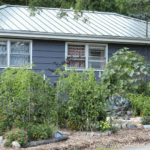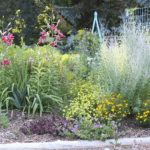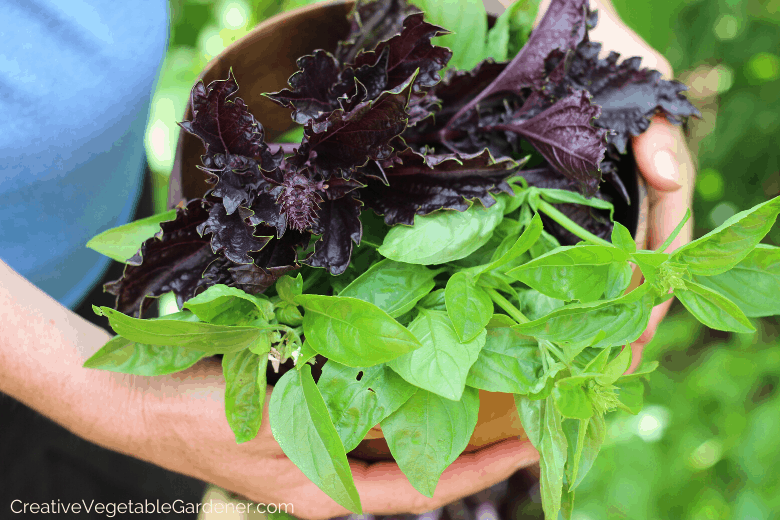
My best tips for growing basil: fun varieties, when and how to plant, and harvesting techniques to keep it producing all season long.
There are lots of great reasons to include herbs in your vegetable garden – they’re forgiving plants to grow for gardeners of all levels, harvesting your own homegrown herbs will help you save money at the grocery store, and adding fresh herbs to a dish can really elevate your cooking to a whole new tasty level.
And if you regularly purchase basil from the grocery store then growing basil in your home garden is a no-brainer!
Basil is easy to grow, smells amazing (like summer I always proclaim!), keeps producing leaves and stems for many months once it gets going in early summer, and comes in many unique varieties.
In this article, I’m sharing the best tips for growing basil, my favorite varieties, and techniques for keeping the plant healthy and producing big harvests.

Tips for Growing Basil: Varieties & Plant Sources
Annual vs. Perennial
There are two categories of herbs: annuals, which must be planted every year, and perennials, which in many gardening zones and climates come back year after year, so you only need to plant them once.
Herbs like oregano, mint, onion chives and thyme are perennial herbs. Basil is an annual herb. This means you’ll need to start your own plants at home in late winter or plan to purchase plants from your local farmers market or nursery.
What Varieties of Basil to Grow
Basil is probably the herb that comes in the largest number of varieties. There are so many fun basils to grow! Remember, one of the benefits of growing your own food is that you can try out interesting and unique varieties. Don’t just grow the boring old basil you can get from any grocery store.
I’ll link to sources for these seeds in the next section.
Sweet Basil
The most common basil varieties are the sweet basils. These are the types typically found at your grocery store. They have large leaves and are popular to use in cooking and making pesto.
Genovese is a well-known variety that grows well in most gardens.
Italian Large Leaf
Eleonora
In the last several years there’s been a disease affecting basil called downy mildew. My basil plants were infected one year and I had to rip them all out because they were covered in a fuzzy mold.
For this reason, I now try to grow at least one variety that says it’s resistant to Downy Mildew. It should say so in the variety description in the seed catalog. Eleonora is one of those varieties.

The gorgeous Purple Ruffles Basil
Purple Basil
A lot of basil varieties are green, but there are a few that are purple. I highly recommend mixing some purple basil into your garden. It’s such a great pop of color amongst all of the green of the vegetable plants.
Purple Ruffles is my absolute favorite purple variety because the leaves are so striking. I’ve grown it every season for as long as I can remember!
Purple Dark Opal
You can use purple basil like you would the green varieties, fresh in salads and sprinkled on top of dishes, or mix it into pesto and sauces.
If you’re excited about the idea of making purple pesto, I’m sorry to break it to you, but it turns out more of a gray color than purple. I know! Very disappointing.
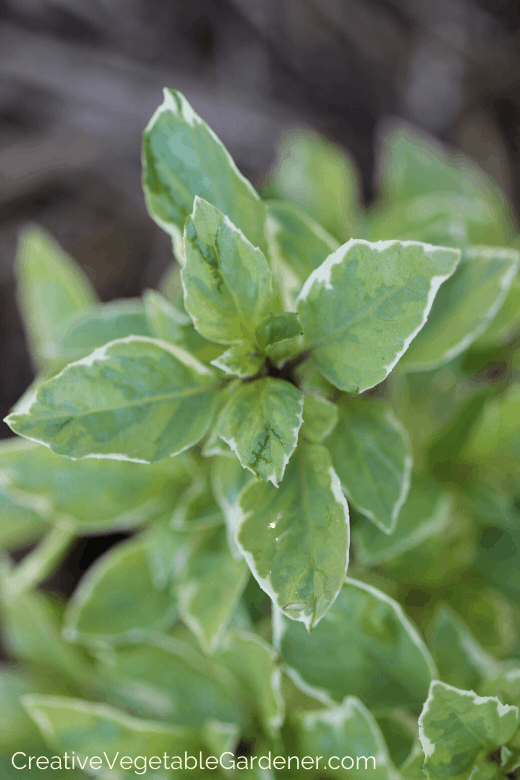
Basil Perpetuo!
Variegated Basil
I’m obsessed with different colored vegetable plants! I’m not talking about the vegetables they produce, I’m talking about the actual plant.
Unlike perennials, shrubs, and trees, which come in interesting variegated leaf varieties, that’s not as common with vegetable plants.
There are a few I’ve found over the years, and the basil family features one!
Perpetuo is mostly sold as basil that’s been bred not to go flower and go to seed, which is handy as you’ll find out later in this post. But, I fell in love with it because of its coloring.
It also has more of an upright shape than the other basils. So far I haven’t been able to track down seeds to grow them myself (I think it’s patented), so you may have to be on the lookout for a plant instead.
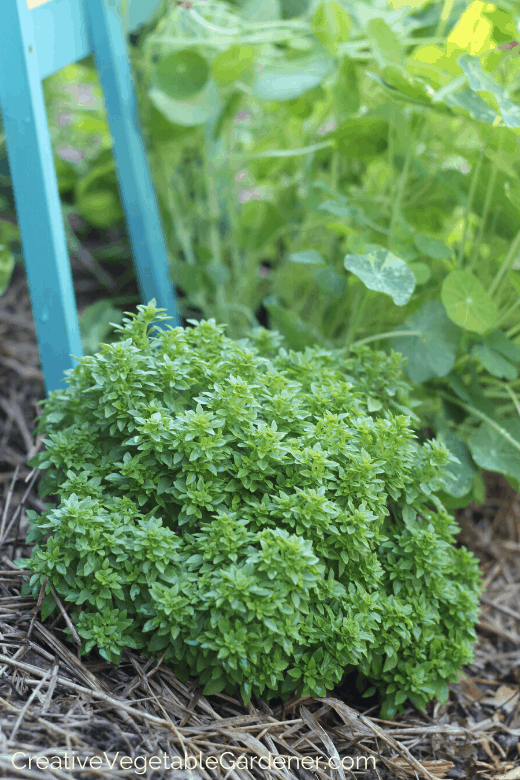
Globe Basil
Globe or Greek basils are another unique kind of basil because the plant is small and round and the leaves are tiny. They’re great for scattering onto dishes and salads without the need to chop them.
They’re so little you can easily fit them into small spaces in your garden or landscape.
More Basil Options
The options just don’t end! I told you there were a lot of basil varieties.
Thai or Holy Basil
Lemon Basil
Cinnamon Basil
Lime Basil
Really, just make sure you try some different varieties and have fun with it!
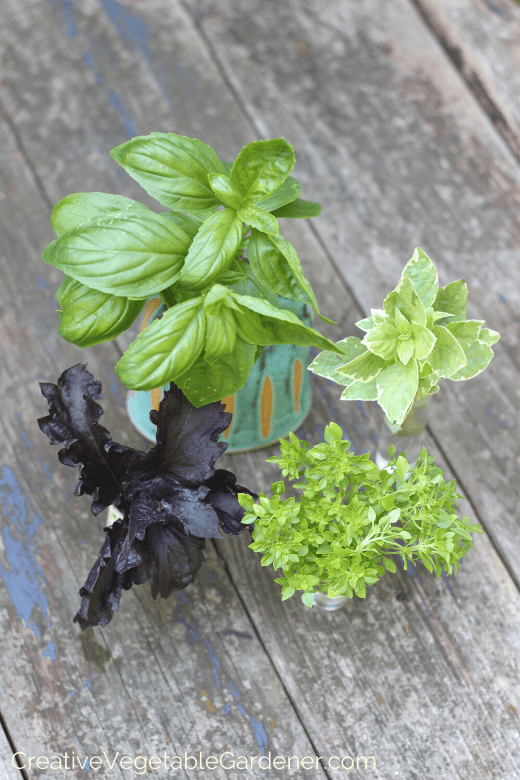
Sourcing Basil Plants & Seeds
Basil is a transplanted vegetable, which means you’ll need a seedling, or plant, in order to grow it in your garden. You should not plant basil seed directly in the soil outside, especially if you live in a colder climate.
It grows slowly at first, so you won’t get much of a harvest before it turns cold and the basil dies.
If you start your own seeds at home you should definitely add basil to your list! It’s very easy to start from seed inside and you’ll have access to many unique and interesting varieties.
If you purchase your plants in spring, you can plan to shop at your local farmers’ market or nursery and pick up your plants.
I love this line of herb plants which I found at one of my favorite nurseries in Madison. (Kleins Nursery if you live near me.)
My favorite seed companies offer many of the varieties you learned about in this article:
Etsy: I gathered some of my favorite varieties from different sellers at this link.
Amazon: Find my recommended varieties, tools, supplies, books, and more in my Amazon storefront here.
I also wrote an article Where to Buy Vegetable Seeds and Plants! Don’t Make These Mistakes.
Tips for Planting & Growing Basil
How Much Basil Should You Plant?
If you love basil a lot and use it often in cooking, you might want to plant several different kinds, not just one plant. In my large garden (approx. 1600 square ft.) I grow 15 plants every season.
There is no way I’d be able to use all of this fresh, but the reason I plant so many is that I use it for making pesto and herb sauces to freeze for winter.
If you only want a few leaves for garnish several times a week, you can probably get away with planting only one seedling.
But, if you love the idea of making pesto for pizza and pasta, you’ll need a lot more basil, possibly as many as five plants if you’re eating these dishes often.
And if you want to make pesto or other sauces to stock your winter pantry, then I’d suggest experimenting with more than five plants and keeping track of whether you think that’s enough.
You can always plant more next year!
Once the weather heats up and basil starts growing quickly, you should be able to harvest from the plants once or twice a week (or more if you’re only taking a few leaves) all throughout the season until your first frost.
When to Plant Basil
The most important thing to know about basil is that unlike a lot of the other herbs it’s not frost hardy. In fact, it can often get damaged at temperatures around 38 degrees F.
This is why you absolutely must wait until you’re sure your last frost has passed in spring. For me, in zone 5 that’s at the same time I plant my peppers, tomatoes, eggplant, and other hot weather vegetables – around mid to late May.
If you not sure how to figure that out, you can read through this post.

How to Plant Basil
If you’re growing a lot of basil together in a garden bed you can space your basil about 12” apart in rows.
This bed is about four feet wide and I’ve planted three rows down the length of the bed. You can see I’ve staggered the rows and put 12” between each of the plants in the row.
If you’re planting just a basil seedling or two, you can squeeze it in at the end or corner of a garden bed. Keep in mind that basil doesn’t get very tall, so you should plant it on the south side (in northern climates) of taller plants so it doesn’t get shaded.
If you want to learn more about how to prep your garden beds for planting and how to correctly plant seeds and seedlings, check out this post and video.
After planting, make sure your basil gets about one inch of water per week from rainfall and/or manual watering. Basil, like most herbs, likes its leaves on the drier side, so I don’t recommend watering with overhead sprinklers.
I like watering with a hose and wand attachment.

Tips for Harvesting & Storing Basil
Harvesting Basil
One of the best tips for growing basil is to prevent it from flowering. The way to encourage the plants to continue to grow new basil stems and leaves is to just keep harvesting!
When harvesting, take a close look at your plant and cut right above the spot where there are two small leaves.
Leaving these leaves sets the plant up to grow two more stems that you’ll be able to harvest in a few weeks. You can cut your basil plant down pretty aggressively if you always cut at this point.
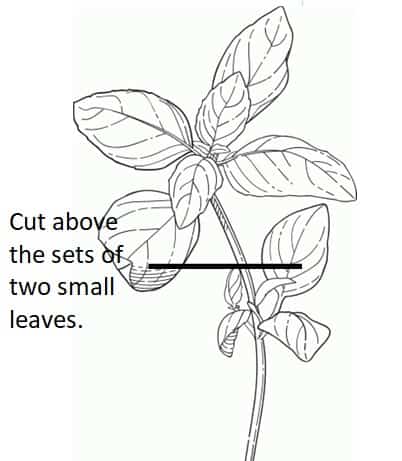
Just make sure enough leaves remain so the plant can photosynthesize. Sometimes I just go out and harvest a few stems to use in a recipe, but if I want to make pesto or another sauce for freezing I’ll go through the whole patch and harvest as much as possible.
To harvest, you can use regular household scissors like I’m doing in the photo above.
I also keep these clippers and these harvest scissors by my kitchen door for quick missions out to the garden while I’m cooking dinner.
Again, the best way to keep it growing new leaves is to continually cut off the flowers it keeps trying to push up. Once plants flower and go to seed their energy shifts away from leaf production and towards reproduction.
Basil also has a tendency to turn bitter in taste at this phase of the plant’s life.
Because basil is so sensitive to cold weather you’ll notice it start to degrade slowly as fall approaches. It will be one of the first plants to die when your garden gets hit by frost.
At this late point in the season, the plant usually isn’t very vigorous anymore so I just let it get killed by the first frost.

Storing Basil
Basil doesn’t like cold temperatures, so if at all possible try not to store it in the fridge. I like to keep it in the garden until right before I’m going to use it.
If you do need to store some for a while, it’s better to keep it on the counter in a jar with water. You can cover it with a plastic bag if you’d like.

Preserving Basil
When the summer season arrives you might find that you’re basil plants are going bonkers and you have more than you can eat fresh. This is when I go through the bed and do a big harvest so I can spend some time preserving a taste of summer for winter cooking and eating.
Learn my favorite recipes and best methods for how to preserve basil.
Now that you’re equipped with the best tips for growing basil this season it’s time to figure out where you’re going to plant it, how many plants you want to grow, which varieties sounds like fun to have in your garden, and whether you’re going to start your own plants or buy seedlings. Happy basil growing!
Additional Resources for Growing Herbs
FREE MINI COURSE
My free mini-course, Getting Started Growing Herbs in Your Garden, is a small taste of the below Masterclass. The mini-course features 5 videos and worksheets to help you:
- Learn why growing herbs is SO easy and worth it!
- How to choose which herbs to grow in your garden.
- Where to plant your herbs so they’ll be successful.
MASTERCLASS
My how-to video series, All About Gardening with Herbs: Your Guide to Growing, Harvesting, Cooking With, & Preserving a Bounty of Herbs, is my most popular class! If you’re ready to delve more deeply into the wondrous world of growing your own herbs, find out more here.
Cilantro can be a very challenging herb to grow. That’s possibly why this post is one of the most popular on my site: How to Prevent Cilantro From Bolting and Tips For Successful Growing.
Herbs can become a joyful part of your gardening season each year if you take the time to learn about them. Your first step is to incorporate these tips for growing basil this season.
Consider planting some basil plants if you haven’t before, and if you’ve grown basil for many years, I encourage you to experiment with some new varieties to keep gardening fresh and exciting for you.








